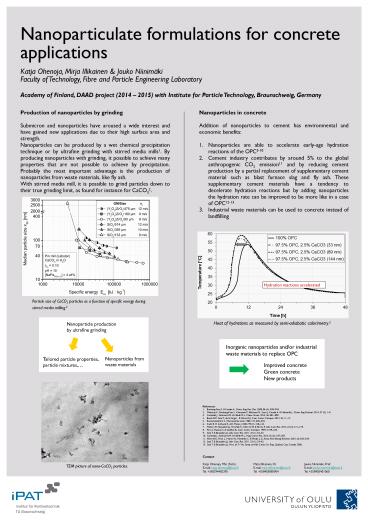Production of nanoparticles by grinding - PowerPoint PPT Presentation
1 / 1
Title:
Production of nanoparticles by grinding
Description:
Nanoparticulate formulations for concrete applications Katja Ohenoja, Mirja Illikainen & Jouko Niinim ki Faculty of Technology, Fibre and Particle Engineering Laboratory – PowerPoint PPT presentation
Number of Views:33
Avg rating:3.0/5.0
Title: Production of nanoparticles by grinding
1
Nanoparticulate formulations for concrete
applications
Katja Ohenoja, Mirja Illikainen Jouko Niinimäki
Faculty of Technology, Fibre and Particle
Engineering Laboratory Academy of Finland, DAAD
project (2014 2015) with Institute for Particle
Technology, Braunschweig, Germany
- Production of nanoparticles by grinding
- Submicron and nanoparticles have aroused a wide
interest and have gained new applications due to
their high surface area and strength. - Nanoparticles can be produced by a wet chemical
precipitation technique or by ultrafine grinding
with stirred media mills1. By producing
nanoparticles with grinding, it possible to
achieve many properties that are not possible to
achieve by precipitation. Probably the most
important advantage is the production of
nanoparticles from waste materials, like fly ash. - With stirred media mill, it is possible to grind
particles down to their true grinding limit, as
found for instance for CaCO32.
- Nanoparticles in concrete
- Addition of nanoparticles to cement has
environmental and economic benefits - Nanoparticles are able to accelerate early-age
hydration reactions of the OPC3-10 - Cement industry contributes by around 5 to the
global anthropogenic CO2 emission11 and by
reducing cement production by a partial
replacement of supplementary cement material such
as blast furnace slag and fly ash. These
supplementary cement materials have a tendency to
decelerate hydration reactions but by adding
nanoparticles the hydration rate can be improved
to be more like in a case of OPC12-13 - Industrial waste materials can be used to
concrete instead of landfilling
Hydration reactions accelerated
Particle size of CaCO3 particles as a function of
specific energy during stirred media milling.2
Heat of hydrations as measured by semi-adiabatic
calorimetry.2
- References
- Breitung-Faes S. Kwade A., Chem. Eng. Res. Des.
2008, 86 (4), 390394. - Ohenoja K., Breitung-Faes S., Kinnunen P.,
Illikainen M., Saari J., Kwade A. Niinimäki J.,
Chem. Eng. Technol. 2014, 37 (5), 19. - Camiletti J., Soliman A.M. Nehdi M.L., Mater.
Struct. 2013, 46, 881898. - Bentz D.P., Sato T., de la Varga I. Weiss
W.J., Cem. Concr. Compos. 2012, 34, 1117. - Ramachandran V. S., Thermochim. Acta 1988, 127,
385394. - Kadri E. H. Duval R., ACI Mater. J. 2002, 99
(2), 138142. - Makar J.M., Beaudoin J.J., Trischuk K.,Chan G. W.
Torres F., Adv. Cem. Res. 2012, 24 (4),
211219. - Péra J., Husson S. Guilhot B., Cem. Concr.
Compos. 1999, 21,99105. - Sato T. Beaudoin J.J., Adv. Cem. Res. 2011, 23
(1), 3343. - Camiletti J., Soliman A.M. Nehdi M.L., Mag.
Concr. Res. 2013, 65 (5), 297307. - Worrell E., Price L., Martin N., Hendriks C.
Meida L.O., Annu. Rev. Energy Environ. 2001, 26,
303329. - Sato T. Beaudoin J.J., Adv. Cem. Res. 2011, 23
(1), 3343. - Sato T. Beaudoin J.J., Proc. of 2nd Int. Symp.
on Adv. Concr. Sci. Eng., Quebec City, Canada
2006. - Contact
TEM picture of nano-CaCO3 particles.































